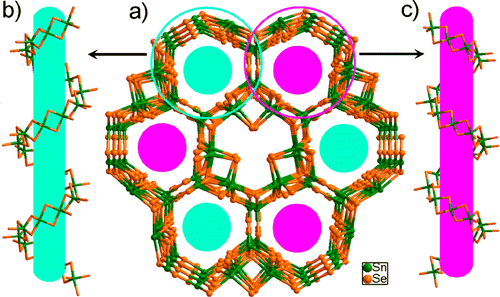,
College of Chemistry, Chemical Engineering and Materials Science, Soochow University, Suzhou 215123, People’s Republic of China
Inorg. Chem. 2014, 53, 9267-9273
The novel iron selenidostannates [Fe(bipy)3]Sn4Se9·2H2O (1) and [Fe(bipy)3]2[Sn3Se7]2·bipy·2H2O (2) (bipy = bipyridine) were prepared by the reactions of Sn, Se, FeCl2·4H2O, bipy, and dien with/without KSCN under hydrothermal conditions (dien = diethylenetriamine). In 1, four SnSe5 units condense via edge sharing to form the novel 3-D framework selenidostannate ∞3[Sn4Se92–] containing an interpenetrating channel system. The [Fe(bipy)3]2+ cations are accommodated in the different channels according to the conformation of the [Fe(bipy)3]2+ cation. In 2, three SnSe5 units share edges to form a 2-D ∞2[Sn3Se72–] layered anion, while two SnSe5 units and one SnSe4 unit are connected via edge sharing, forming a 1-D ∞1[Sn3Se72–] chainlike anion. The ∞1[Sn3Se72–], [Fe(bipy)3]2+, bipy, and H2O species are embedded between the ∞2[Sn3Se72–] layers. 2 is the first example of a selenidostannate constructed by both ∞2[Sn3Se72–]and ∞1[Sn3Se72–] anions. The coexistence of 1-D ∞1[Sn3Se72–] and 2-D ∞2[Sn3Se72–] anions in 2 might support the possible reaction mechanism that the ∞2[Sn3Se72–] anions are formed by condensation of the ∞1[Sn3Se72–] chains. 1 and 2 exhibit band gaps at 1.43 and 2.01 eV, respectively.

链接: